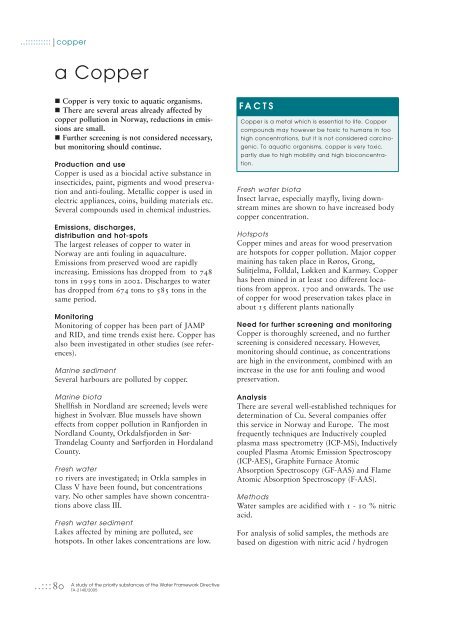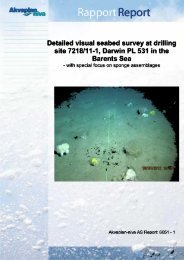A study of the priority substances of the Water Framework Directive ...
A study of the priority substances of the Water Framework Directive ...
A study of the priority substances of the Water Framework Directive ...
Create successful ePaper yourself
Turn your PDF publications into a flip-book with our unique Google optimized e-Paper software.
..:::::::::: copper<br />
..:::80<br />
a Copper<br />
� Copper is very toxic to aquatic organisms.<br />
� There are several areas already affected by<br />
copper pollution in Norway, reductions in emissions<br />
are small.<br />
� Fur<strong>the</strong>r screening is not considered necessary,<br />
but monitoring should continue.<br />
Production and use<br />
Copper is used as a biocidal active substance in<br />
insecticides, paint, pigments and wood preservation<br />
and anti-fouling. Metallic copper is used in<br />
electric appliances, coins, building materials etc.<br />
Several compounds used in chemical industries.<br />
Emissions, discharges,<br />
distribution and hot-spots<br />
The largest releases <strong>of</strong> copper to water in<br />
Norway are anti fouling in aquaculture.<br />
Emissions from preserved wood are rapidly<br />
increasing. Emissions has dropped from to 748<br />
tons in 1995 tons in 2002. Discharges to water<br />
has dropped from 674 tons to 585 tons in <strong>the</strong><br />
same period.<br />
Monitoring<br />
Monitoring <strong>of</strong> copper has been part <strong>of</strong> JAMP<br />
and RID, and time trends exist here. Copper has<br />
also been investigated in o<strong>the</strong>r studies (see references).<br />
Marine sediment<br />
Several harbours are polluted by copper.<br />
Marine biota<br />
Shellfish in Nordland are screened; levels were<br />
highest in Svolvær. Blue mussels have shown<br />
effects from copper pollution in Ranfjorden in<br />
Nordland County, Orkdalsfjorden in Sør-<br />
Trøndelag County and Sørfjorden in Hordaland<br />
County.<br />
Fresh water<br />
10 rivers are investigated; in Orkla samples in<br />
Class V have been found, but concentrations<br />
vary. No o<strong>the</strong>r samples have shown concentrations<br />
above class III.<br />
Fresh water sediment<br />
Lakes affected by mining are polluted, see<br />
hotspots. In o<strong>the</strong>r lakes concentrations are low.<br />
A <strong>study</strong> <strong>of</strong> <strong>the</strong> <strong>priority</strong> <strong>substances</strong> <strong>of</strong> <strong>the</strong> <strong>Water</strong> <strong>Framework</strong> <strong>Directive</strong><br />
TA-2140/2005<br />
FACTS<br />
Copper is a metal which is essential to life. Copper<br />
compounds may however be toxic to humans in too<br />
high concentrations, but it is not considered carcinogenic.<br />
To aquatic organisms, copper is very toxic,<br />
partly due to high mobility and high bioconcentration.<br />
Fresh water biota<br />
Insect larvae, especially mayfly, living downstream<br />
mines are shown to have increased body<br />
copper concentration.<br />
Hotspots<br />
Copper mines and areas for wood preservation<br />
are hotspots for copper pollution. Major copper<br />
maining has taken place in Røros, Grong,<br />
Sulitjelma, Folldal, Løkken and Karmøy. Copper<br />
has been mined in at least 100 different locations<br />
from approx. 1700 and onwards. The use<br />
<strong>of</strong> copper for wood preservation takes place in<br />
about 15 different plants nationally<br />
Need for fur<strong>the</strong>r screening and monitoring<br />
Copper is thoroughly screened, and no fur<strong>the</strong>r<br />
screening is considered necessary. However,<br />
monitoring should continue, as concentrations<br />
are high in <strong>the</strong> environment, combined with an<br />
increase in <strong>the</strong> use for anti fouling and wood<br />
preservation.<br />
Analysis<br />
There are several well-established techniques for<br />
determination <strong>of</strong> Cu. Several companies <strong>of</strong>fer<br />
this service in Norway and Europe. The most<br />
frequently techniques are Inductively coupled<br />
plasma mass spectrometry (ICP-MS), Inductively<br />
coupled Plasma Atomic Emission Spectroscopy<br />
(ICP-AES), Graphite Furnace Atomic<br />
Absorption Spectroscopy (GF-AAS) and Flame<br />
Atomic Absorption Spectroscopy (F-AAS).<br />
Methods<br />
<strong>Water</strong> samples are acidified with 1 - 10 % nitric<br />
acid.<br />
For analysis <strong>of</strong> solid samples, <strong>the</strong> methods are<br />
based on digestion with nitric acid / hydrogen

















